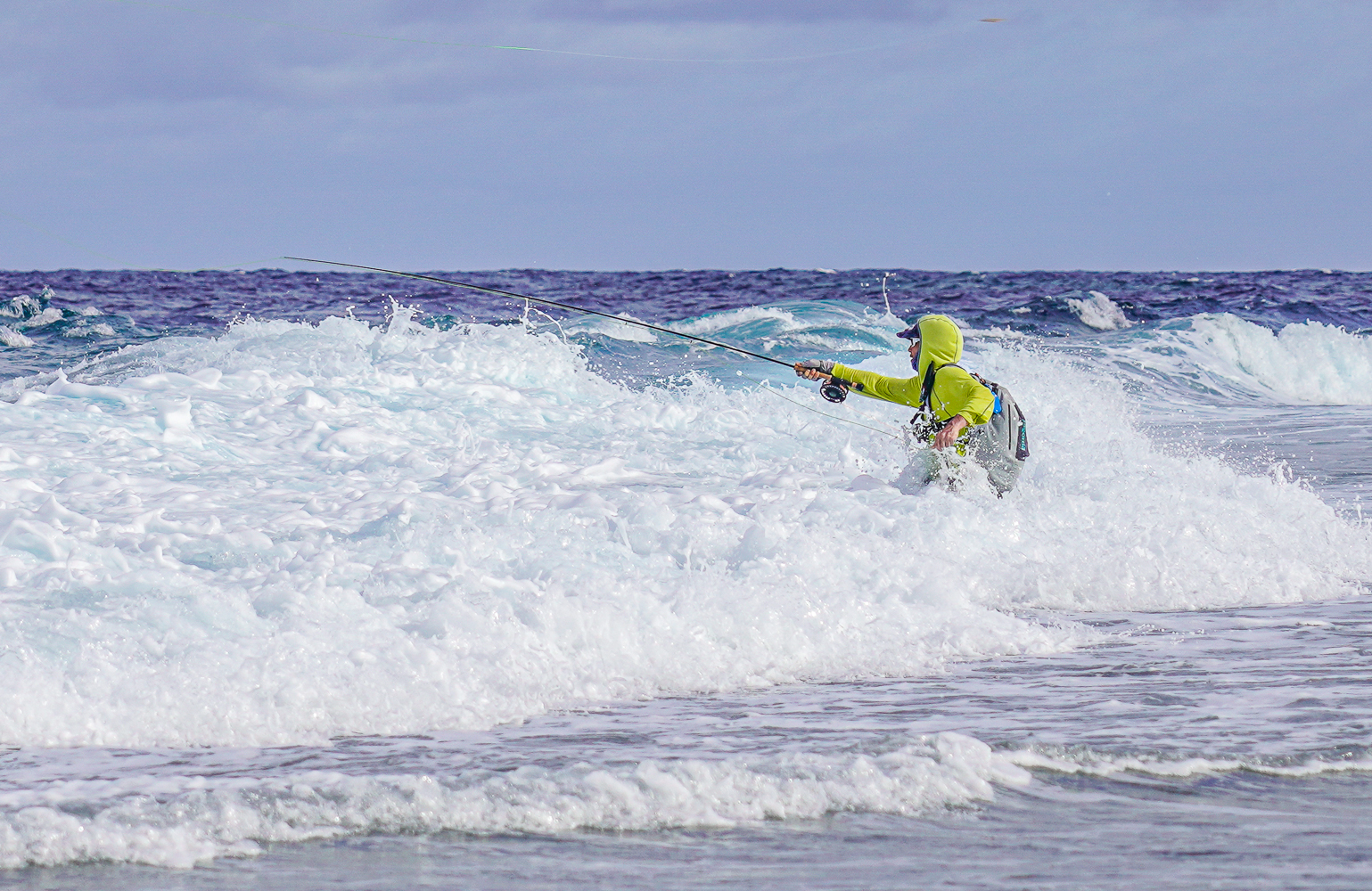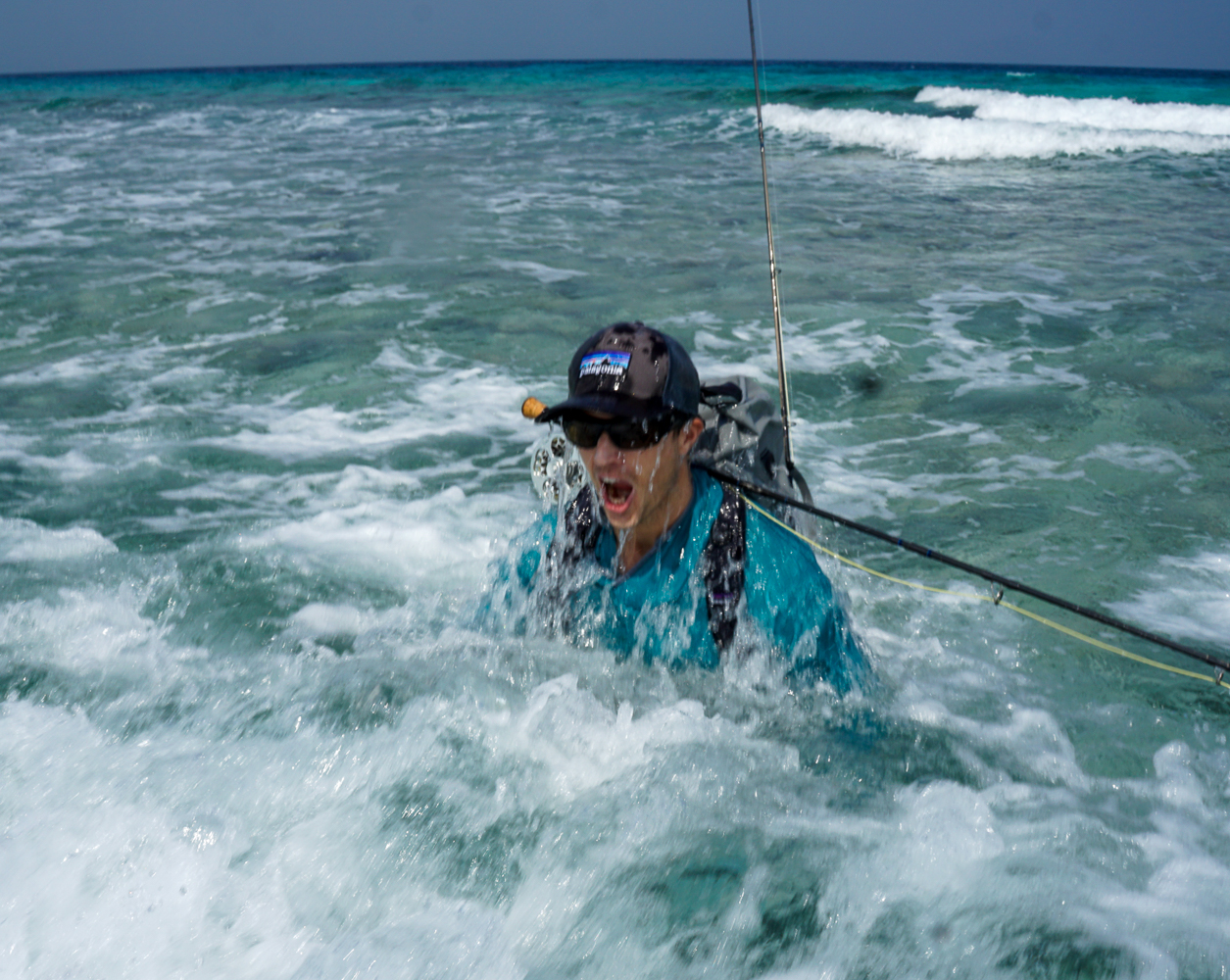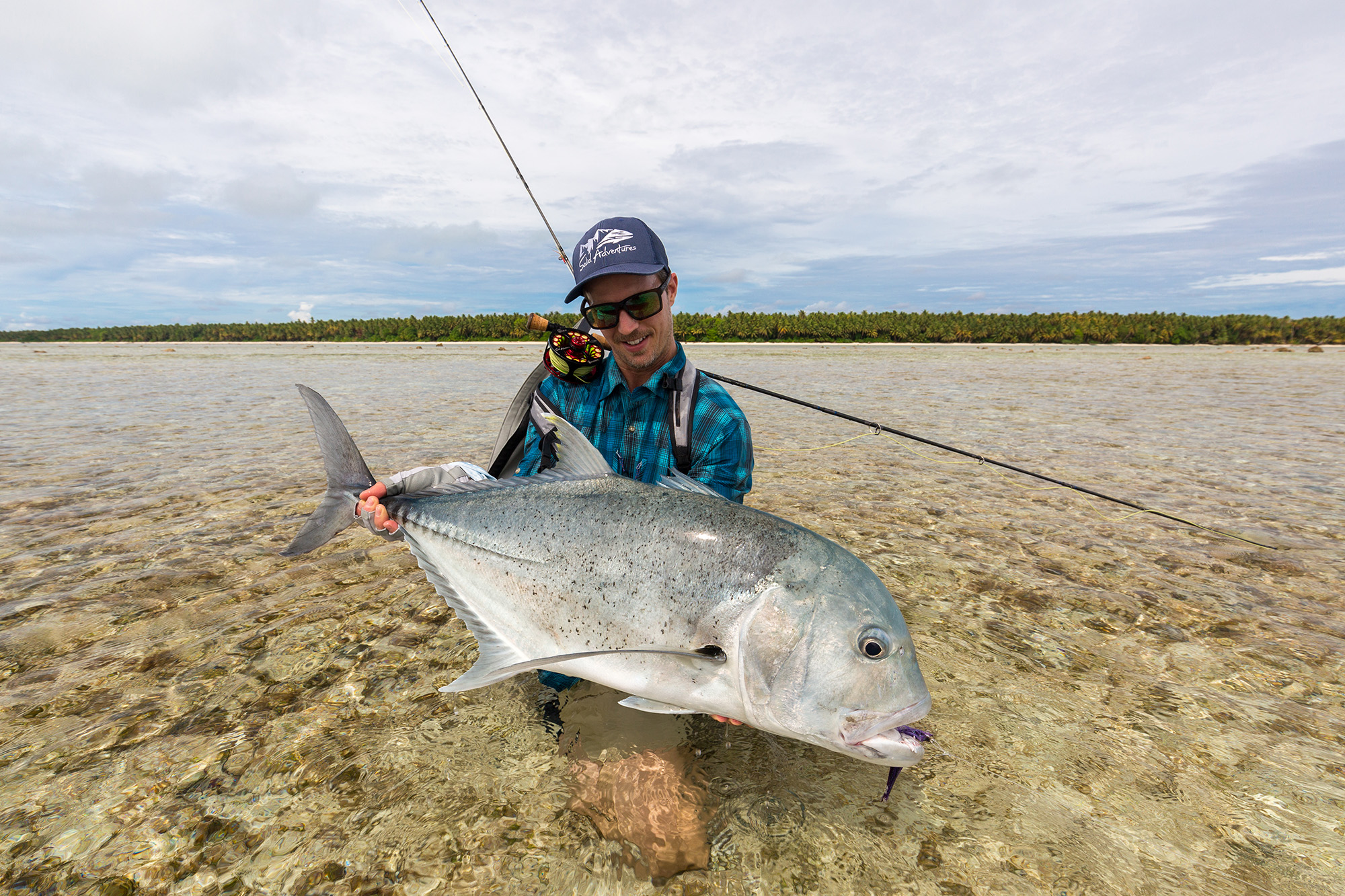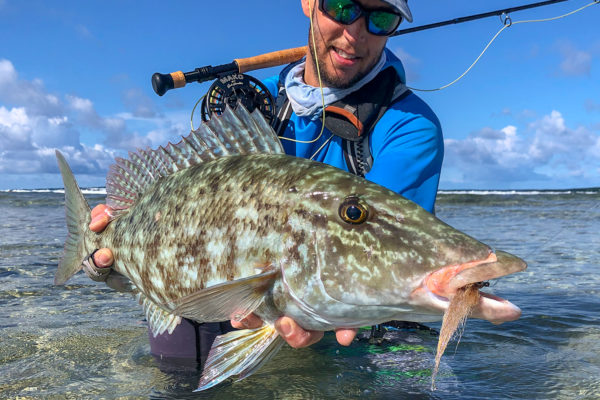So you’re currently considering packing your bags to go chasing GT with a fly rod! Great, you’re about to get into some serious fun! To help you on your way we’ve prepared this short, general advisory and FAQ based on the most common questions we tend to get from our clients prior to a trip. Hopefully it will both inspire and give you some guidance during your preparations and ultimately help you perform when it counts, in GT territory.
Make sure you know what you’re in for
The good old saying, “fail to prepare = prepare to fail” applies to most fishing situations but when hunting Giant Trevally the reality will hit you hard and it will be brutal. In all honesty, there probably isn’t a lot that can be said or read that will truly prepare you for your first encounter with one of the so called gangsters of the flats. GT fishing is violent and at some level even a bit scary. It usually goes from zero to 100 in a split second and after walking for sometimes hours you are expected to perform at your best in a split second. This is when your preparations comes into play, when that casting practice pays off and the investments in having the right gear makes all the difference in the world.
As an angler with a fly rod in your hand, wading a reef edge or rocky flats area, your chances to land even a decent size GT are far from favourable. Being prepared and knowing that at least you’ve done all within your power, using the best possible equipment, from rod and reel to leader, hooks and the knots you’ve tied, is something you owe yourself after making the trip all the way this exotic place you’re currently fishing. And let’s face it: No matter where you are fishing or how much money you have paid to fish there, you will most likely not have too many chances to hook and land a GT in a day, or sometimes even in a week, so if you are skilled and lucky enough to actually hook one, you will want to land it!

Three keys to success
Below we have identified three areas that we think are critical to focus on in order to get the most out of your trip.
1. Casting: Even if you are used to carry and cast a 12 weight rod from the front of a skiff this is a different game in a different stadium. Wading the surfline of a reef edge or covering ground over bigger flats areas looking for Giant Trevally demands quick decisions and even quicker casting. Very often it’s a matter of seconds determining whether you’ll have a cow GT cruising by, disappearing out of reach before you realize what happened, or an explosion of water followed by a screaming reel and line flying through the guides of your rod! To maximize your chances we recommend you practice casting before the trip using GT lines rigged with hookless GT flies. Bare in mind that at times you will be waist deep in the surf and the better your casting is, the more you can capitalize on your shots. Being able to cast 35 Meters on grass is great. But can you put the line 15 Meters out when you are in the surf wading knee or even waist deep? Because that’s exactly what you need to do at times. When you have a fish in sight you often have a window of a couple of seconds to get some line in the air and the fly in the water. At this stage every false cast you make in the direction of the fish dramatically decreases your chances!

2. Mindset: One of the most important things when hunting for GT is your expectations and your attitude. Fly fishing for GT is demanding and physical and definitely not for everyone. If you expect 20 good shots a day on GT, well then get ready to be disappointed. Seeing multiple fish during a session with 2 to 4 real shots a day is considered a good day. Don’t be fooled by all the pictures flying around on Facebook, Instagram, and other social media sites. It is not easy and not everyone will succeed on every trip. Before you embark on your trip we recommend you read week reports from several GT destinations around the globe to get a realistic idea of what GT fishing really is. Don’t expect these fish to jump you! Most of today’s well-known and established GT destinations don’t produce GT on the fly for every rod, every day, or even every week. Every GT on a fly rod is a victory and worth celebrating! No matter where you fish. It can be easy at times but most of the time you have to put quite a bit of work in. One of the hardest parts with stalking flats and reefs for GTs’ is to stay focused for a whole session and don’t let your mind drift too much. It’s easy to get into periods of just moving without actually looking around you. But if you stay positive and ready, always with the fly in your hand ready to cast – then eventually it will happen and you will be the angler posing with your first of hopefully many GT’s!
3. Be flexible: If for some reason the GT fishing doesn’t produce the way it usually does, be willing to chase some other species or try some different methods. Most GT destinations have very specific windows where your chances to spot and hook a GT on the flats are good, and there are periods where your time could be better spent chasing other species. Most GT destinations offer good opportunities to chase triggerfish, Bonefish, Indo-pacific Permit, and more. Also, don’t be afraid to leave the flats and fish deeper water from a boat, perhaps even with a spinning rod. Having fun with a spinning rod in between fly sessions can be super fun and a great way to recharge your batteries between fly sessions! If you are an absolute fly fishing purist, refusing to grab a spinning rod, you can always try the tease and switch game where someone is casting a hookless popper, trying to get the attention of GT’s in deeper water. As soon as you see some action you make a cast with your fly rod and hope for the best. The reason for using a spinning rod to tease fish is simply that you cover more water and can attract fish from greater distances than if you blind cast over deep water with a fly rod. And let’s face it: you’ve probably travelled a long way to be in this fishing paradise so why not maximise your fun while on location. And if you have never tried fishing for GT, Tuna, or whatever is out there with a spinning rod and popper you’re in for a surprise!
Tackle and set up
The universal fly rod for chasing GT on the flats is a #12 weight saltwater model with enough backbone to cast big flies in a hurry and put pressure on an average size GT. My personal favorite is the Scott Meridian series which I’ve used for several years now and it has never let me down so far. However there are many great saltwater rods out there and most important is that you find one that works for you and your casting technique. Just remember to cast it with a GT line and fly before you embark on your trip to make sure you have a set up that works for you.
If you’ve ever seen photos or video from someone GT fishing you’ve probably noticed that there usually is another rod strapped to the angler. Most times that spare rod is a lighter rod, most likely an 8 or 9 weight, ready to use if you encounter triggers, permit, bonefish, or any smaller species. Our general recommendation when fishing GT is to carry a 12 weight rod in your hand and have a 9 weight easily accessible. A 9 weight will be able to handle most other species you may encounter and will also give you a decent chance if a GT appears when you are looking for triggers or other species and don’t have time to make the switch to the bigger rod.
If possible we recommend that you pack a spare GT rod with you on the trip as well. These fish fight hard and dirty and unfortunately breaking a rod is quite common. On our last scouting trip to Napoleon City alone our anglers ended up breaking two rods in 6 days of fishing.
Lines: In terms of lines most brands have specific GT lines these days. Make sure you get one in a size that matches your rod and casting skills. Floating lines are to prefer for flats fishing but it can be fun to bring some sinking models for trolling a line behind the boat between sessions.
Leaders: We normally fish straight 7 – 9 foot mono or fluorocarbon leaders in 120 – 150 lbs. Some anglers prefer to fish thinner leaders in the 80 – 100 lbs range but unless you are fishing a spot with a relatively high amount of fishing pressure, or are getting clear refusals from fish that are following your fly but not biting, there is no need to fish anything less than 120 lbs. Bigger fish can easily wear out a 150 lb leader if you fight it for a while and some anglers prefer to use 170 lbs or even bigger. GT’s usually run for the reef edge or circle rocks and break your leader scraping the sharp edges. Therefore the thicker your leader the bigger your chances to land the fish. With thicker leaders you will obviously have a harder time tying nice knots but most of the premium mono and fluoro carbon producers have really nice soft versions today making it easier to tie decent looking knots.
Flies: While plain black or tan Brush flies have been seen in most GT boxes for years, combinations like black/purple and black/red are becoming increasingly popular and have proven very efficient. Other universal favorites are olive and red Semper flies, big Deceiver flies, and NYAP Poppers in various colors. NYAP (not your average popper) are great to use when fishing deeper water, like a deep channel or lagoon, as it makes more noice and can attract fish from far away. Due to its slim design the NYAP is easier to cast than your normal popper and the surface strikes you get are something else.
There are obviously a whole range of different flies available that will work great. What is important is that the flies you use are tied on premium hooks. Our favorites are the Gamakatsu SL12s or TMC 600SP in sizes 4/0, 6/0 and 8/0. Equally important is that you fish a fly you can cast and can cast fast! It is more important to get a fly out there that the fish will actually see than to have a beautiful fly that never makes the distance in time! My favorite go to GT fly these days is simply called the GT from Salar Flies. It is super easy to cast, I’ve barely had any refusals on it, and it’s tied on the Gamakatsu SL12s hook. If I’m not using that then I probably have a tan or black Brush fly tied to my leader.
Carrying a second rod
A: As mentioned before, it is important to be strapped with two rods: One for GT, the other one for everything else. It really doesn’t make any sense to carry three rods at the same time. On the contrary it will only hinder you in your fishing. The secondary rod needs to be stowed away easily accessible and yet out of the way of the casting hand rod. One efficient and popular way of carrying your secondary rod is to place the rod but in the pocket of your pants, and have the rod stick up under the shoulder strap of your backpack and out behind your shoulder, under your armpit. If you are a right hand caster your rod should be in your left side pocket coming up on your left side. Make sure to practice the rod change a few times before you enter the flats so that you know exactly how to make the switch.
Other Advice, Tips & Tricks
Bring good wading shoes! The surf area is the place to be for the bigger GT’s and the coral-rubble can be sharp and the wear and tear on wading equipment is immense. A pair of neoprene shoes will not be enough if you plan to wade more than the sand dunes. If possible wear neoprene socks in your wading shoes.

Have as few slings and straps flying around as possible. These things are a guarantee for disaster. Your line will always find a way to get tangled and once a fish hits there is no way to get the line untangled . We have seen numerous fish being lost or shots being blown because of that. If you want to use a GoPro don’t wear a chest harness. It’s the perfect line trap.
A waterproof backpack is a must. Make sure it is one that is actually waterproof and not just water resistant. Wading the flats in waist deep water means your backpack will be partly in the water at times. There may also be times when you want to wade through or swim across deeper spots where we use our backpacks as floating devices. There will also be occasions on the flats or reefs where you need to take your backpack off to get something out or simply drop it in the water for a quick rod change. Our team and scouts are using Patagonia backpacks because they have never failed us but there are other premium brands that work as well. If you want to buy something cheaper or something you have never tried before please check it in your bathtub or sink before your trip to be sure. Spending some extra minutes checking your pack before your trip is way better than picking up a wet camera after a session on location.

Bring shorts or long pants that don’t rub your inner thighs or crotch area. A pair of compression pants under your shorts are super comfortable and will keep you rash free.
Make sure you bring a premium saltwater reel with a water sealed brake system. Your reel will be exposed to saltwater almost constantly when wading or fishing the surf. We have seen a bunch of reels fail in various ways, like breaks completely locking up or do the opposite and start free spooling, and handles just corrode away. Make sure that your gear is prepared. Our team are currently fishing Einarsson Plus Series reels (Insert link) but there are other great reels like the Mako from Mako Reel Co, and many more that will do the trick. Again, if possible, bring a spare reel or two. Better safe than sorry!
An easily accessible fly box for wading/fishing is needed. This means in your pocket and not in your backpack. We usually carry a smaller box with a selection of our Go To flies in a chest pocket or somewhere on us and keep a bigger selection in our backpacks. Remember to clean your flies in fresh water after each section to avoid rusty hooks.
Camera: These days most of our guests tend to bring water resistant smartphones as their preferred camera. If however you want to bring more serious camera equipment, make sure to keep your gear in an extra watertight bag inside of your backpack. Pack a stack of napkins or a roll of toilet paper in a ZipLock bag to clean your lens from drops of water when you are taking photos in the water.
Bring some of your favorite Power Bars as a backup for long sessions on the flats or walks along the reef.
Water bottle and hydration tablets. Fishing in the sun all day means you will sweat and lose a lot of salt and minerals. To avoid headache or worse it’s important to hydrate a lot and if possible mix your water with hydration tablets containing vital salts and minerals so that you can stay focused during the whole fishing session.
We strongly recommend that you bring at least two pairs of premium glasses rigged with different color polarized lenses. Conditions and sight will vary and it is vital to always see through the surface. We are currently using Costa sunglasses because they have been great and offer all the lenses we need but choose something that fits you and works for your eyes. Bring a cloth and cleaning spray or tissues to clean them every day. Always carry a cloth or lens wipes on you to clean your glasses when on the flats. Since we often wade surf zones or areas with some commotion your glasses will be hit with splashes of water several times during a session. There is also the sunscreen that seems to constantly make it onto your lenses.
Clean your gear in freshwater. If you can rinse your rod and reel every day that is great but since some locations may be short on fresh water you may have to wait until you’re back home. If so, drop your rods, reels, glasses, and flies in the bathtub or shower and make sure to give them a real rinse. If not your gear will suffer the consequences of salt exposure and you’ll be left with rusty hooks, guides, and locked up brakes.
Last but not least
We know some of what you just read may seem a bit daunting and perhaps you are not sure whether this is really for you! Well good! You should think about it and make sure you know what you are in for. But with that said you don’t have to be fit like a Crossfit champ or a world class caster to fish for GT. You just have to take it a bit serious and prepare as best you can, both in terms of gear as well as physically and mentally. It is important to know what to expect and with this piece of information we simply want to give you as an angler an unfiltered description of what to prepare for. Walking the flats or reef looking for patrolling GT’s, getting shots at triggers, bones, and even permit, freaking out trying to switch rods when a GT approaches out of nowhere and you are standing there with your 9 weight rigged with a Crazy Charlie on 16 lbs tippet…it’s all part of the fun and every GT hunter will recognize the feeling! Embrace it all and this is some of the most addictive, challenging, heart breaking, adrenaline pumping and ultimately rewarding fly fishing on the planet!
If you want to read more about GT fishing and get some really good insights and recommendations about everything from what gear to use to GT behavior on different locations, we recommend to check out Peter McLeod’s book “A Fly Fisher’s Guide to Giant Trevally”.
See you on the water


















